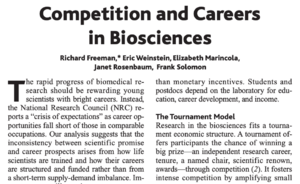Competition and Careers in Biosciences
Richard Freeman, Eric Weinstein, Elizabeth Marincola, Janet Rosenbaum, and Frank Solomon's paper "Competition and Careers in Biosciences" discusses the challenges facing young scientists in the biomedical field, despite the sector's rapid progress. The authors identify a "crisis of expectations," where career opportunities for Ph.D. life scientists are less favorable compared to other fields requiring similar education levels. This issue is attributed to the structure of bioscience careers, characterized by a tournament-like model that amplifies minor productivity differences into significant disparities in career outcomes. This competitive environment exerts pressure on researchers to work long hours, prioritize rapid publishing, and employ cheap labor in the form of postdocs and graduate students, often at the expense of quality training.
The paper argues that the lengthy training period and relatively low compensation result in lower lifetime earnings for bioscientists. Additionally, inadequate career information contributes to a misalignment between scientific ambitions and actual job prospects. Despite these challenges, the number of Ph.D. graduates in the field continues to grow, particularly among women and international students, due in part to the intellectual appeal of the field and adjusted recruitment strategies. To improve career prospects, the authors recommend reforms such as increasing fellowships, raising stipends, providing independent funding opportunities, and supporting alternative career paths. These changes, supported by collective action from institutions and funding agencies, could help create a more sustainable and rewarding career structure in the biosciences.
Summary by Section
Introduction
The paper begins by highlighting a "crisis of expectations" in biomedical research. Despite rapid progress in the field, young scientists face limited career opportunities compared to other high-education professions. The authors argue that this discrepancy results from the way life sciences careers are structured, including training, funding, and career incentives.
The Tournament Model
The research landscape in biosciences is likened to a tournament, where researchers compete for major prizes like tenure or independent research positions. The model amplifies small productivity differences into significant disparities in recognition and reward. It fosters a competitive environment where even minor advantages, such as completing an experiment slightly earlier, can lead to substantial gains. This structure exerts immense pressure on principal investigators (PIs) to be constantly productive, often leading to long work hours and high levels of competition, especially among early-career scientists.
Consequences
While tournaments can motivate high productivity, they may also produce negative outcomes. The intense competition encourages rapid publishing and the recruitment of large numbers of postdoctoral researchers, often at the expense of meaningful training experiences. This focus on output over personal development can harm young scientists' career growth. Additionally, the competitive environment disproportionately affects those with caregiving responsibilities, such as mothers, due to the long hours required to keep up with the field's rapid pace.
Lifetime Earnings
The duration of training in biosciences is notably long, with Ph.D. and postdoctoral stages collectively spanning over a decade. The paper discusses how this lengthy training period, combined with relatively low wages, results in lower lifetime earnings for bioscientists compared to other high-education fields. The authors highlight that this system benefits funding agencies by providing cost-effective research labor but is less favorable for individual scientists.
Career Information and Supply
There is a significant gap in career information available to prospective bioscience students. Many institutions do not track the job placement of their graduates, leaving students without a clear understanding of career prospects. Survey data indicate that undergraduate students have a negative perception of bioscience career opportunities, influenced by discussions with graduate students, postdocs, and their families. Despite these challenges, the field has seen an increase in Ph.D. graduates, particularly among women and non-U.S. citizens, driven partly by the allure of the science and adjusted recruitment strategies.
Policy Recommendations
The paper concludes with a call for reforms to improve career prospects for young bioscientists. Proposed changes include increasing fellowships for graduate students, raising postdoctoral stipends, providing more independent funding opportunities, and supporting alternative research careers outside the traditional PI track. The authors stress the need for collective action by funding agencies and institutions to make meaningful changes to the existing career structure.
References and Notes
The paper provides references to support its arguments, including studies on work hours, publication rates, and previous reports on the career trajectory of life scientists.
